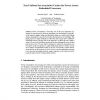119 search results - page 1 / 24 » Static Energy Reduction Techniques for Microprocessor Caches |
ICCD
2001
IEEE
14 years 1 months ago
2001
IEEE
Microprocessor performance has been improved by increasing the capacity of on-chip caches. However, the performance gain comes at the price of increased static energy consumption ...
CF
2005
ACM
13 years 7 months ago
2005
ACM
Technology projections indicate that static power will become a major concern in future generations of high-performance microprocessors. Caches represent a significant percentage ...
EUC
2004
Springer
13 years 10 months ago
2004
Springer
Abstract. Power consumption is becoming one of the most important constraints for microprocessor design in nanometer-scale technologies. Especially, as the transistor supply voltag...
CSREAESA
2003
13 years 6 months ago
2003
Energy dissipation in cache memories is becoming a major design issue in embedded microprocessors. Predictive filter cache based instruction cache hierarchy is effective in reduci...
MICRO
1997
IEEE
13 years 9 months ago
1997
IEEE
Most modern microprocessors employ one or two levels of on-chip caches in order to improve performance. These caches are typically implemented with static RAM cells and often occu...

